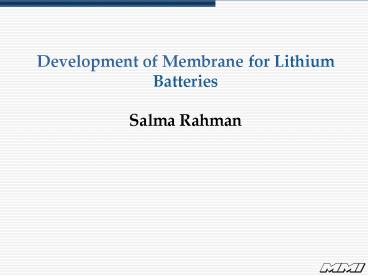Development of Membrane for Lithium Batteries - PowerPoint PPT Presentation
1 / 21
Title:
Development of Membrane for Lithium Batteries
Description:
Development of Membrane for Lithium Batteries Salma Rahman Current Market for Rechargeable Lithium-ion Batteries First commercialized in 1991 Now preferred ... – PowerPoint PPT presentation
Number of Views:506
Avg rating:3.0/5.0
Title: Development of Membrane for Lithium Batteries
1
Development of Membrane for Lithium
Batteries Salma Rahman
2
Current Market for Rechargeable Lithium-ion
Batteries
- First commercialized in 1991
- Now preferred rechargeable battery chemistry
for portable consumer electronics - Estimate over 2.2 billion Li-ion cells will be
manufactured in 2010 for portable applications
3
Advantages of Lithium-ion Batteries
- Volumetric and gravimetric energy exceeds other
rechargeable chemistries (NiMH, NiCd, Lead Acid) - Good power density
- Reasonable cost, very low dollar per watt hour
- Cell voltage well matched to portable
applications (3.7 V nominal) - Good life cycle
- Low self-discharge
- No memory effect
NOTE MMI has been working towards the
development of novel electrolytes for Li-ion
batteries based on patended polymeric materials.
4
Lithium-air Batteries
- First introduced in 1996
- Uses atmospheric oxygen as the cathode active
material - Lithium (usually combined with another metal
such as nickel, - manganese, etc) as an anode
- A novel electrolyte as a medium for the ions to
cycle through.
The limiting component is the air cathode, which
must be porous to allow enough oxygen into the
cycle for efficient battery power.
5
Li-air Batteries
M Oxygen Permeable Membrane C Composite
Positive Electrode A Lithium anode (negative
electrode) S Separator
Schematic representation of a polymer
electrolyte-based Li/Oxygen battery
6
MMIs approach for the Membrane
Design and prepare polymers with
organosilicon and perfluorocarbon containing
hyperbranched polymers (HBPs)
Crosslink these polymers into membranes with
required properties.
7
Synthesis of Hyperbranched Polymer (HBP)
8
Fabrication of HBP Membranes
Blend of HB-PCS (or fluoro HB-PCS) and
HB-PCS-trimethoxysilane (or fluoro
HB-PCS-trimethoxysilane)
Dilute the blend (if needed) using
isopropanol and add catalyst
Support membrane
Cure at 80oC for 4 h
Immerse in polymer blend, 1 min (each side)
9
Photographs of Support Membrane and HB-PCS /
fluoro HBP Coated Membranes
Fluoro HBP coated on PTFE support membrane
HBP coated on PTFE support membrane
PTFE support membrane
10
Membrane Morphology
Cross sectional view of HBP membrane coated on
support membrane
SEM image of the Cross sectional view of HBP
membrane
11
Evaluation of Membrane Barrier Properties (Oxygen
and Water Vapor Permeability)
MOCON barrier testing instrument
12
Evaluation of Support Membranes
Oxygen and water vapor permeability of HBP
membranes fabricated on different support
membranes
Sample Support membrane Oxygen permeability (Barrer) Water vapor permeability (Barrer)
1SR-742-9-2 Free standing 3.0 x 104 27.4
2SR-742-3-1 PTFE (polypropylene backing) 2.3 x 104 1) 23.3 (membrane 1) 2) 23.2 (membrane 2)
2SR-742-14-2 PTFE (polyethylene backing) 5.3 x 105 2.2 x 102
2SR-742-14-3 PVDF 3.0 x 106 1.1 x 102
2SR-742-14-4 Anopore 6.9 x 106 1.7 x 102
1 75/25 blend of HB-PCS and HB-PCS-trimethoxysila
ne (no dilution). 2 75/25 blend of HB-PCS and
HB-PCS-trimethoxysilane (The blend was 2x diluted
using isopropanol).
PTFE support membrane (polypropylene backing)
performs best
13
Evaluation of Barrier Properties of the
Membranes from Fluoro HBPs with Different (CH2)x
Chain Lengths
Oxygen and water vapor permeability of
fluorinated HBP membranes1
1PTFE support membrane (polypropylene backing)
were used
14
Determination of Electrolyte Permeability through
Membranes
Dual approaches
15
Swelling Test
Swelling testing of membranes in 11 mixture of
electrolytes
Sample Types of membrane Wt. before immersion (g) Wt. after 72 h immersion 2 h drying at room temp. (g) wt. change (after 74 h) Wt. after 72 h immersion 24 h drying at room temp. (g) wt. change (after 96 h) Physical change
1SR-742-46-A Only Support 0.0682 0.001 0.0857 0.001 26 (gain) 0.0681 0.001 0 Not noticeable
2SR-742-46-B HB-PCS 0.1228 0.001 0.1219 0.001 1 (loss) 0.1214 0.001 1 (loss) Not noticeable
3SR-742-46-C Fluorinated HBP 0.1606 0.001 0.1470 0.001 8 (loss) 0.1460 0.001 8 (loss) Not noticeable
No significant swelling not conducive to
electrolyte permeation
16
Cell for Measurement of Permeation of Organic
Solvents by ASTM F739 Method
Sample for GC analysis
Electrolyte
Test membrane
17
Determination of Permeation of Organic Solvents
utilizing Gas Chromatography
Permeation of electrolytes through fluorinated
HBP -(CF2)8- membranes (in ASTM test cell)
after 1 h
Sample -CF2- chain length Electrolytes Permeability (Barrer)
1SR-742-70 8 Propylene Carbonate 4
1SR-742-76 8 1, 3-Dioxolane 4
1SR-742-77 8 Dimethyl Carbonate 4
1SR-742-80 8 1, 2-Dimethoxyethane 4
Achievement of low organic electrolyte
permeability ( 1 Barrer)
18
Chemical resistivity of fluoro HBP -(CF2)8-
membranes
Chemical resistivity of fluorinated HBP
-(CF2)8- membrane in mixture (equal ratio) of
electrolytes
Sample Wt. before immersion (g) Wt. after 96 h immersion lyophilization (g) wt. loss (after 96 h) Wt. after 120 h immersion lyophilization (g) wt. loss (after 120 h)
1SR-742-41-2 0.1535 0.001 0.1291 0.001 16 0.1289 0.001 16
Note ATR-FTIR spectrums of both sides of the
membranes were also collected before and after
immersion.
Very good chemical resistance
19
Oxygen and water vapor permeability of HBP
-(CF2)8- membranes in simulated environment
Oxygen and water vapor permeability of HBP
(-CF2-)8 membranes before and after exposure
to electrolytes (in ASTM test cell).
Sample Chemical exposure Exposure time Oxygen permeability (Barrer) Water vapor permeability (Barrer)
1SR-742-20-1 No - 1.7 x 104 16.5
1SR-742-43 Propylene carbonate 1 day 1.3 x 105 11.6
1SR-742-83 1,3-Dioxolane 1 day 5.1 x 104 60
1SR-742-84 Dimethyl carbonate 1 day 1.1 x 105 77
1SR-742-85 1,2-Dimethoxy ethane 1 day 9.3 x 104 64
1SR-742-69 Propylene carbonate 32 days 4.2 x 104 22.5
20
Concluding Remarks
Conclusions
Acknowledgements
- The funding for this program has been provided by
Army Research Laboratory Grant No.
W911SR-05-C-0026. - MaxPower, Inc. has been the consultant to this
program.
21
Future Work































